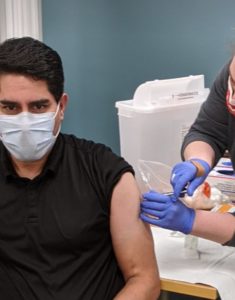COVID vaccine will go first to health care and essential workers, residents of long-term facilities and high risk population
Health care personnel, residents of long-term facilities, workers in essential and critical infrastructure, and people at high risk for severe COVID-19 illness are recommended to be the first groups to get the COVID vaccine, according to interim guidelines issued Dec. 11 by the Michigan Department of Heath and Human Services (MDHHS).
A Dec. 11 Michigan Department of Health and Human Services (MDHHS) press release announced the interim guidance for COVID-19 vaccine prioritization for the state of Michigan, MDHHS, public health and health care.
The seven-page interim guidance outlines the strategy to attain the MDHHS initial operational goal to vaccinate 70 percent of adults or approximately 5.4 million people by end of 2021.

Local otolaryngologist and surgeon, Dr. Bobby Mukkamala posted on his Facebook page a photo of himself receiving the COVID vaccine.
Following Center for Disease Control and Prevention (CDC) and the federal Advisory Committee on Immunization Practices (ACIP), the MDHHS interim guidance defines Michigan priority population groups in detail and in two phases of the COVID-19 vaccine offering.
Here are the Phase descriptions as detailed by the MDHSS:
Phase 1 outlines 3 priority levels, A-C:
– Health care personnel and the health care system, as well as residents of long-term facilities
(1A).
– Workers in essential and critical infrastructure, workers with unique skill sets, non-hospital and non-public health labs, mortuaries; staff in k-12 schools, childcare, shelters, corrections, congregate childcare, protective services (1B.)
– People at high risk for severe COVID-19 illness due to underlying medical conditions, and people 65 years and older (1C).
Phase 2 comprises mass vaccination for all adults over age 18 and those not covered in Phase 1.
Phases 1 and 2 may overlap; timing depends upon supply, allocation from the federal level to Michigan, and capacity to administer the vaccine. Two graphs illustrate the sequence and overlap of phases.
MDHHS priorities within phases 1 A-C may change with the availability of more information and additional vaccine products.
The MDHHS interim guidance outlines the risk situation of Health Care Personnel (HCP) and the different work settings. The guidance also comprises persons employed in essential and critical infrastructure
(defined by the Cybersecurity & Infrastructure Security Agency or CISA)
Per CDC/ACIP guidelines, the MDHHS interim guidance notes the need for early vaccine access for persons with underlying medical conditions The guidance reminds older adults that risk increases with age
MDHHS will follow ACIP goals and ethical principles to prioritize allocation of limited supply.
MDHHS also uses the CDC Social Vulnerability Index (CDC SVI) to allocate limited supply, targeting distribution of supplies by geography within vaccination phases. CDC SVI status in Michigan communities correlates with the communities hardest hit by COVID-19. Each phase must include outreach strategies for people in at-risk groups who have difficulty accessing community vaccination.
The seven page MDHHS press release on the Covid-19 vaccine can be read in its entirety here:
MI COVID-19 Vaccination Prioritization Guidance 121120 (1)EVM Staff can be reached at eastvillagemagazineflint@gmail.com


You must be logged in to post a comment.